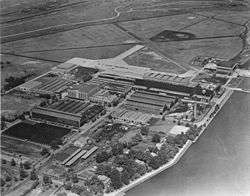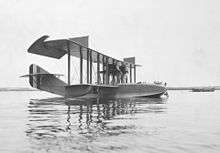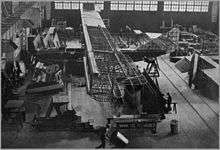Naval Aircraft Factory
The Naval Aircraft Factory (NAF) was established by the United States Navy in 1918 in Philadelphia, Pennsylvania. It was created to help solve aircraft supply issues which faced the Navy Department upon the entry of the U.S. into World War I. The US Army’s requirements for an enormous quantity of airplanes created a decided lack of interest among aircraft manufacturers in the Navy's requirements for a comparatively small quantity of aircraft. The Navy Department concluded that it was necessary to build a Navy-owned aircraft factory in order to assure a part of its aircraft supply; to obtain cost data for the department’s guidance in its dealings with private manufacturers; and to have under its own control a factory capable of producing experimental designs.
| Naval Aircraft Factory | |
|---|---|
 Aerial view of the NAF | |
| Site history | |
| Built | 1917 |
| In use | 1917-1945 |
| Battles/wars | First World War Second World War |
History
.jpg)
On 27 July 1917, Secretary of the Navy Josephus Daniels approved the project; the contract was let on 6 August 1917 and ground was broken four days later. The entire plant was completed by 28 November 1917, 110 days after ground breaking. When it was completed the greatest need was for patrol flying boats, so production of the H-16 patrol aircraft was started. On 27 March 1918, just 228 days after ground breaking and 151 days from receipt of drawings, the first H-16 built by the NAF was successfully flown. On the following second of April the first two NAF-built H-16s were shipped to the patrol station at RNAS Killingholme, England. After World War I, when the 1922 United States Navy aircraft designation system came into effect, the second letter of the codes designating the manufacturer appropriately specified the latter N for all airframe designs coming from the Naval Aircraft Factory.
In 1922, full-scale production of outside designs ended and the NAF began concentrating on the testing and evaluation of aircraft, including both the modification to outside types and all-new in-house designs. Successful designs were then turned over to industry for production. The change in focus resulted in the disuse of some production buildings, which were converted into storage depots for unused aircraft.[1] In 1922-1923, the NAF fabricated the USS Shenandoah (ZR-1), although final assembly took place at Naval Air Station Lakehurst, New Jersey, where the only hangar in the United States large enough to house the airship was located.[2]
In the 1934, under the Vinson-Trammell Act (co-sponsored by Carl Vinson), it was decided that the Navy would build 10 per cent of its own aircraft to stay abreast of modern manufacturing techniques and costs. The NAF thus resumed large-scale aircraft production in 1936 on introduction of the N3N biplane trainer aircraft. The NAF ended aircraft production with the end of World War II in 1945.[3] The existence of the Naval Aircraft Factory was controversial at times, as it put a federally funded industrial activity in direct competition with civilian industry, and this was one of the reasons it was disestablished. Upon disestablishment, the aircraft test functions were passed to the newly formed Naval Air Test Center at Naval Air Station Patuxent River, Maryland.
Located at the Philadelphia Naval Shipyard, on League Island, the main construction building still exists, but was converted for use by the Naval Surface Warfare Center Carderock Division, as a facility for research and development.
Products



- BN & BS - cancelled projects[5][6]
- CS-3 - biplane torpedo bomber, variant of the Curtiss CS-2[7]
- Felixstowe F5L - patrol flying boat, variant of the Felixstowe F.5 produced by NAF[4]
- FN - cancelled fighter project,[8] possibly a proposed further development of the Seversky NF-1, but evidence of this is inconclusive and may stem from typos in Navy records[6][N 1]
- GB - Giant Boat, prototype heavy flying boat, never completed
- MF - utility flying boat, variant of the Curtiss MF produced by NAF[9]
- N-1 - pusher floatplane gunship[6]
- N2N - biplane trainer
- N3N Canary - biplane trainer
- NM - Navy Metal, experimental biplane built to test metal structure techniques[9]
- NO - observation floatplane, also built by Martin as M2O[9]
- OS2N Kingfisher - observation floatplane, variant of the Vought OS2U Kingfisher produced by NAF
- PBN Nomad - patrol flying boat, variant of the Consolidated PBY Catalina produced by NAF
- PN - patrol flying boat derived from the Felixstowe F5L
- PT - torpedo bomber floatplane built by NAF from Curtiss R-6L and Curtiss HS2L parts[9]
- SA - Ship's Airplane, prototype ultralight aircraft intended for basing on battleships[6]
- SBN - carrier-based scout bomber, Brewster XSBA-1 produced by NAF under license
- SON Seagull - observation floatplane, variant of the Curtiss SOC Seagull produced by NAF
- SP - racing monoplane built for Schneider Trophy, known as Mercury Racer[6]
- TDN - early unmanned combat aerial vehicle
- TD2N, later KDN Gorgon - jet-powered target drone[10]
- TD3N, later KD2N Gorgon II - jet-powered target drone[10]
- TF - twin-engine flying boat prototype intended for use as escort fighter
- TG - biplane floatplane designed for gunnery training
- TR - racing variant of the NAF TS-2
- TS - biplane fighter
- VE-7 - biplane fighter and trainer aircraft, Vought VE-7 produced by NAF
- XN5N - monoplane trainer prototype
- XOSN - observation floatplane prototype[9]
- XP2N and XP4N - initial and final designations given to the PN-11 prototype, an improved variant of the PN patrol flying boat[9]
- XTN - twin-engine torpedo bomber prototype, later put into production by Douglas as T2D and P2D
- XT2N - carrier-based biplane torpedo bomber prototype[9]
- USS Shenandoah (ZR-1) - rigid airship (fabrication of parts for off-site final assembly)[2]
References
Notes
- Under the 1922 United States Navy aircraft designation system, the designation of the initial production version of the NAF fighter would have been FN-1, which is very similar to NF-1.
Citations
- Swanborough & Bowers 1976, pp. 326-327.
- Swanborough & Bowers 1976, p. 523.
- Swanborough & Bowers 1976, p. 327.
- Molson, Kenneth M. (1978). "The FELIXSTOWE F5L". CROSS & COCKADE GREAT BRITAIN JOURNAL. 9 (2): 49, 51, 52. Retrieved 7 July 2017.
- Swanborough & Bowers 1976, p. 528.
- "American airplanes: NAF". Aerofiles.com. 2008-08-15. Retrieved 19 May 2019.
- Bowers, Peter M. (1979). Curtiss Aircraft 1907–1947. London: Putnam. p. 191. ISBN 0-370-10029-8.
- Swanborough & Bowers 1976, p. 530.
- Johnson, E.R. (2011). United States Naval Aviation 1919-1941. Aircraft, Airships and Ships Between the Wars. Jefferson, North Carolina, and London: McFarland & Company, Inc. pp. 14, 29, 11, 134, 147, 178–179, 317. ISBN 978-0-7864-4550-9.
- Friedman, Norman (1982). U.S. Naval Weapons: every gun, missile, mine, and torpedo used by the U.S. Navy from 1883 to the present day. Annapolis, MD: Naval Institute Press. ISBN 978-0-87021-735-7.
Bibliography
- Roberts, Michael D. Dictionary of American Naval Aviation Squadrons Volume 2 Washington, D.C.: Naval Historical Center, Department of the Navy, 2000.
- Swanborough, Gordon; Bowers, Peter M. (1976). United States Navy Aircraft since 1911 (2nd ed.). Annapolis, Maryland: Naval Institute Press. ISBN 0-87021-968-5.CS1 maint: ref=harv (link)
- Trimble, William F. Wings for the Navy: A History of the Naval Aircraft Factory, 1917-1956. Annapolis: Naval Institute Press, 1990. 413 pp.
- Trimble, William F. "The Naval Aircraft Factory, the American Aviation Industry, and Government Competition, 1919-1928." Business History Review 60 (Summer 1986): 175-198.
External links
| Wikimedia Commons has media related to Naval Aircraft Factory. |